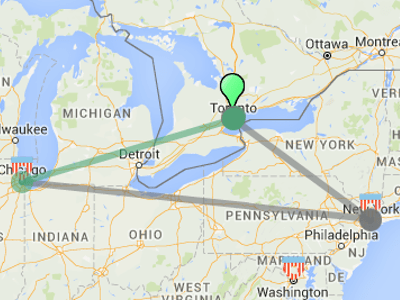IXmaps illustrates how your “local” data travels through the NSA’s jurisdiction

 A new online database called IXmaps has gone live, put together by University of Toronto researchers and funded by the .CA Community Investment Program, to help Canadians understand how their data traffic moves, particularly how it moves through nodes in the United States and therefore under the jurisdiction of the U.S. National Security Agency.
A new online database called IXmaps has gone live, put together by University of Toronto researchers and funded by the .CA Community Investment Program, to help Canadians understand how their data traffic moves, particularly how it moves through nodes in the United States and therefore under the jurisdiction of the U.S. National Security Agency.
The project is also designed to offer Canadians a sense of agency, in that you personally can contribute to the project, adding to the 40,000 internet routes already crowdsourced in the IXmaps database.
The most concerning point made by the project, for those that didn’t know already, is the fact that even if you’re sending an email from Point A (Halifax, let’s say) to Point B (any other Canadian destination), the data will almost definitely pass through an American data traffic hub and thereby be swept into the NSA info dragnet.
“There is nothing inherently wrong with data moving unencumbered across an interconnected global Internet infrastructure,” says the University of Toronto’s Andrew Clement. “It is, however, critical that Canadians understand the implications of their data being stored on U.S servers and moving through U.S. jurisdiction. ISPs need to be transparent, privacy protective and accountable custodians of user information in this regard. Internet users should be fully informed consumers and citizens when making choices about their sensitive personal data.”
And even if you’re not sending an email, but merely using a service like Facebook, Google, YouTube or Amazon, these are American companies operating in American jurisdictions, and so again, subject to data snooping and the hysterical overreach of the Patriot Act.
“Internet advocates across Canada have long recognised that truly Canadian Internet infrastructure is the only way to keep Canadians’ data under the purview of Canadian laws,” says Canadian Internet Registration Authority CTO Jacques Latour. “At the Canadian Internet Registration Authority we have invested heavily in the east to west backbone of Internet exchanges points required to maintain Canadian Internet traffic routes.”
For people who advocate an “I have nothing to hide” attitude when it comes to either the NSA or CSEC, the fact that the personal email, health information, financial records, social media postings, and all that associated metadata, travels through hubs in foreign jurisdictions should be a concern.
“Few Canadians realize just how much of our everyday Internet traffic travels through the U.S.,” says OpenMedia Digital Rights Specialist Laura Tribe. “You could be in a restaurant in downtown Montréal emailing your friend across the street, and that data could easily be traveling through the U.S., where it’s subject to invasive NSA surveillance. That’s why it’s so important that Canadians pitch in, and help us learn more about the paths our data actually takes online.”
Aside from merely making you paranoid and afraid, the IXmaps project is there to help Canadians contribute to a database designed to illustrate a larger problem, which will hopefully attract the attention of Canada’s privacy commissioner.

Terry Dawes
Writer
